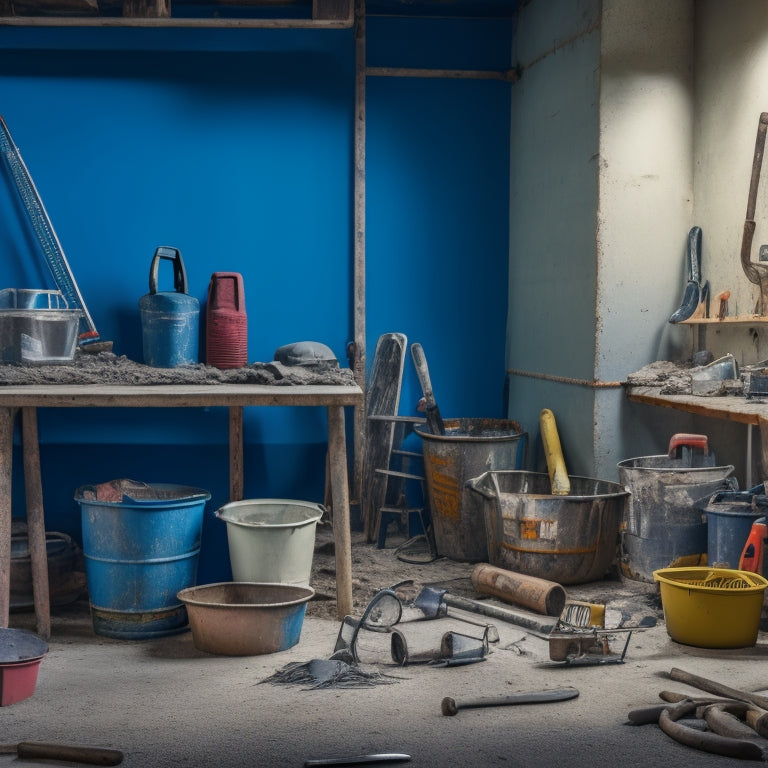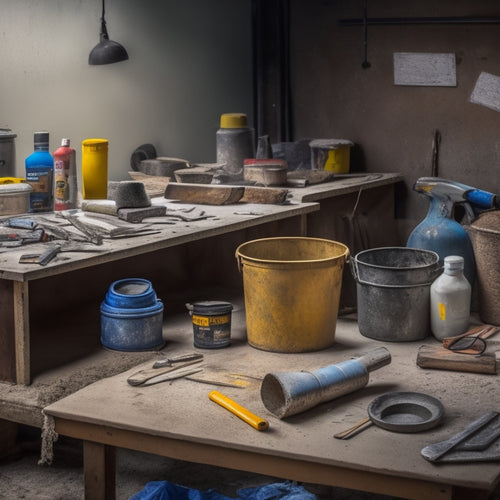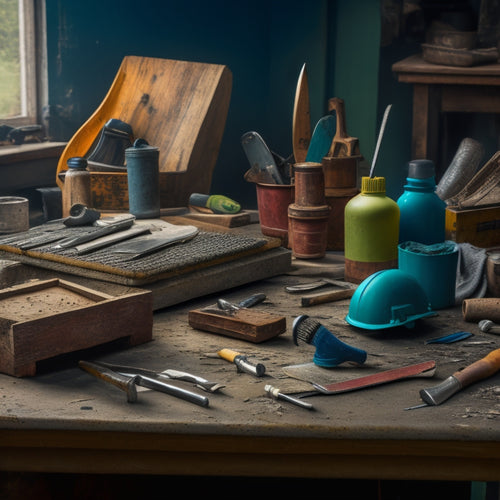
What Tools Do You Need for Concrete Block Walls
Share
You'll need an extensive set of tools to build a concrete block wall, including essential hand tools like trowels, levels, and jointers for laying blocks, as well as specialized equipment for mixing and pouring concrete, such as concrete mixers and vibrating tools. Additionally, you'll require block cutting and shaping tools like block saws and masonry blades, and laying and leveling accessories like spirit levels and laser levels. Finally, don't forget essential safety gear like hard hats, safety glasses, and knee pads. With these tools, you'll be well-equipped to tackle your project, and understanding their proper use will be key to achieving professional results.
Key Takeaways
• Essential hand tools, including a sturdy trowel, level, jointer, pointing trowel, and mixing stick, are necessary for block laying.
• Concrete mixing and pouring equipment, such as a concrete mixer, pouring buckets, vibrating equipment, and finishing tools, are required for project success.
• Block cutting and shaping tools, like block saws, masonry blades, hand saws, chisels, and points, are vital for accurate and efficient block preparation.
• Laying and leveling accessories, including spirit levels, laser levels, block alignment tools, and leveling rods, ensure professional-looking results.
• Safety gear, such as hard hats, safety glasses, dust masks, steel-toed boots, knee pads, and gloves, protect block layers from hazards and injuries.
Essential Hand Tools for Block Laying
When building a concrete block wall, you'll need to equip yourself with a set of essential hand tools that will help you efficiently and accurately lay blocks, guaranteeing a strong and durable structure.
A sturdy trowel is a must-have for scooping and spreading mortar, and mastering trowel techniques is vital for achieving a smooth, even layer.
You'll also need a level to verify the blocks are properly aligned, and a spirit level to check for any deviations from the vertical plane.
A jointer or joint raker is necessary for finishing and smoothing the joints between blocks, while a pointing trowel helps to fill gaps and crevices.
For mortar mixing, you'll need a mixing stick or tamping tool to combine the cement, sand, and water to the right consistency.
Don't forget a pair of gloves to protect your hands from the rough blocks and harsh mortar.
With these hand tools at your disposal, you'll be well on your way to constructing a concrete block wall that's both functional and visually appealing.
Mixing and Pouring Concrete Equipment
By the time you're ready to lay the first course of blocks, you'll have already mixed and poured the concrete footings and foundation walls. This process requires a specific set of equipment to guarantee the concrete is mixed to the right consistency and poured accurately.
For mixing, you'll need a concrete mixer that can handle the volume of concrete required for your project. There are several concrete mixer types to choose from, including drum mixers, pan mixers, and twin-shaft mixers, each with its own advantages and limitations. When selecting a mixer, consider the size of your project, the type of concrete you're using, and the level of precision you need.
When it comes to pouring, you'll need to employ techniques that assure the concrete is placed accurately and evenly. This may involve using pouring buckets or chutes to direct the flow of concrete, as well as vibrating equipment to eliminate air pockets and assure proper consolidation.
Additionally, you may need to use finishing tools, such as tamping rods or screeds, to achieve the desired surface finish. By having the right mixing and pouring equipment, you'll be able to produce high-quality concrete that meets the demands of your project.
Block Cutting and Shaping Tools
With your concrete footings and foundation walls in place, you'll need to prepare your concrete blocks for laying by cutting and shaping them to fit around obstructions and accommodate corners, curves, and other architectural features.
To achieve this, you'll require specialized tools designed for block cutting and shaping. Here are some essential tools to evaluate:
| Tool | Description |
|---|---|
| Block Saws | Heavy-duty saws designed for cutting concrete blocks quickly and accurately |
| Masonry Blades | Diamond-coated blades for use with circular saws or angle grinders |
| Hand Saws | Manual saws for precise cutting and shaping of concrete blocks |
| Chisels and Points | Hand tools for breaking and shaping concrete blocks |
When choosing block cutting and shaping tools, evaluate factors such as precision, speed, and durability. Invest in high-quality tools that can withstand the demands of concrete block construction. By having the right tools, you'll be able to accurately cut and shape your concrete blocks, ensuring a strong and stable structure.
Laying and Leveling Accessories
As you begin laying your concrete blocks, verifying accurate alignment and levelness is essential, and that's where laying and leveling accessories come into play. These tools help you achieve professional-looking results by verifying your blocks are perfectly aligned and level. A spirit level, for instance, is a must-have for detecting even the slightest deviations in levelness. You can use it to check the block's position and make adjustments as needed.
To achieve precise block alignment techniques, consider using a laser level or a string line. These tools project a level line or dot, allowing you to align your blocks with precision. Additionally, a block alignment tool or a masonry straightedge can help you achieve perfectly straight lines.
When it comes to leveling strategies, a leveling rod or a torpedo level can be used to check the block's height and verify it's perfectly level.
Safety Gear for Block Layers
You must prioritize your personal safety when working with concrete blocks, wearing essential gear to protect yourself from hazards like falling blocks, dust, and debris. As a block layer, you're at risk of injury from heavy lifting, tripping, and being struck by objects. To mitigate these risks, wear a hard hat, safety glasses, and a dust mask to prevent respiratory issues.
Steel-toed boots with good traction will prevent slips and trips, while knee pads will reduce fatigue and discomfort.
Proper lifting techniques are vital for injury prevention. Bend at the knees, keep the block close to your body, and lift with your legs rather than your back. Consider using a block lifter or pulley system to reduce manual handling.
Wear gloves with grip to prevent dropping blocks, and keep your work area clean and organized to prevent tripping hazards. Don't forget to stretch regularly and take regular breaks to avoid fatigue.
Frequently Asked Questions
Can I Use Cinder Blocks for Building a Concrete Block Wall?
You're wondering if you can use cinder blocks for building a concrete block wall? Absolutely!
Cinder blocks offer several advantages, including lower cost and lighter weight compared to concrete blocks. However, when it comes to durability and strength, concrete blocks take the lead.
How Do I Estimate the Number of Blocks Needed for a Project?
To accurately estimate the block quantity needed for your project, you'll need to calculate the total square footage of the wall area.
Measure the length, width, and height of each section, then multiply them to get the total square feet.
Divide this number by the square footage of a single block, usually around 1.5 to 2 square feet.
Don't forget to add 10% for cuts and waste.
This calculation will give you a precise block quantity estimation, ensuring your project planning stays on track.
What Is the Best Type of Mortar for Concrete Block Walls?
When selecting the best type of mortar for your concrete block walls, you'll want to evaluate the project's specific requirements.
You'll need to choose from three main mortar types: N, S, and M. N is ideal for general-purpose applications, while S and M are better suited for high-strength and structural projects.
Proper mortar mixing is essential, so make certain you follow the manufacturer's instructions and maintain the correct water-to-cement ratio to achieve maximum strength and durability.
Do I Need to Apply Waterproofing to a Concrete Block Wall?
When building a concrete block wall, you'll need to take into account waterproofing to prevent moisture damage.
You'll want to apply a waterproofing membrane to the exterior of the wall, and possibly a drainage plane behind it.
There are various waterproofing methods to choose from, including coatings, membranes, and sealants.
Don't forget to install a moisture barrier, like a plastic sheet, behind the wall to direct water downwards and prevent seepage.
This will guarantee your wall remains durable and long-lasting.
Can I Build a Concrete Block Wall Without a Footing?
Can you build a concrete block wall without a footing?
Technically, yes, but it's not recommended. Without a proper footing, wall stability is compromised, leading to potential collapse.
However, there are footing alternatives, such as shallow foundations or isolated footings, that can provide adequate support.
You'll need to carefully assess soil conditions, wall height, and load-bearing capacity to determine the best approach.
It's essential to prioritize wall stability to guarantee a safe and durable structure.
Conclusion
Now that you've got your arsenal of tools, it's time to get building!
You've got the essentials for laying blocks, mixing and pouring concrete, cutting and shaping, and leveling and accessorizing.
Don't forget the safety gear to protect yourself from the rigors of the job.
With these tools in hand, can you imagine the stunning concrete block walls you'll create?
Get out there and start building - your next masterpiece awaits!
Related Posts
-

3 Best Tools to Buy for Concrete Repair Online
When buying tools for concrete repair online, you'll want to research multiple retailer options to find the best prod...
-

Must-Have Handheld Tools for Concrete Repair
When tackling a concrete repair project, it is crucial to have the right handheld tools to achieve a professional fin...
-

Why These Concrete Tools Are Always in Demand
You rely on a set of trusted concrete tools to deliver high-quality results, and it's not surprising - these tools ar...


